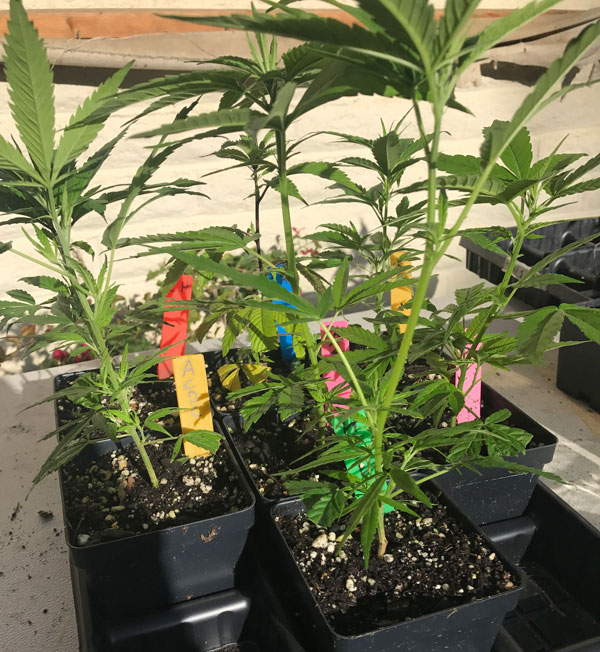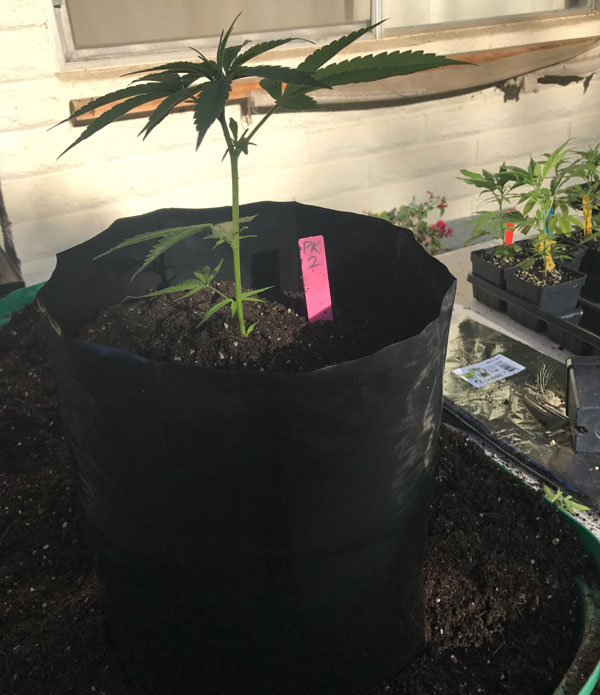First Time Growers: You bought clones, now what?
Congratulations! Ordering your first set of clones is very exciting. Now the fun begins with experimenting and growing one of natures most rewarding plants. Many first time growers will start with anywhere from 4-10 clones/teens.

These clones are approximately 21-28 days from being put into soil. They can grow fast under the right conditions, and once they start growing they take off quick. We use Fox Farm Ocean Forest soil for new clones. Fox Farm has a diverse array of essential organic plant food. Once repotted, we water our plants with filtered hose water. The filters are cheap and screw right into your hose. They work great at removing harmful chlorines and chloramines.
Re-Potting Plants
A big question first time growers always ask themselves, when to re-pot. These clones are certainly ready to transplant, usually anywhere from 3-4 weeks is a good time. If you re-pot too soon, the soil structure will not be strong enough to transplant whole. This will cause growth to be stunted if you lose a large part of your rootball mass. If you re-pot too late, the plant roots will be root bound and roots will not get enough food and will be stunted.
A good sign when your plants are ready to transplant is needing to water every 24-36 hours in a stretch of 3-4 days. You can always check by holding the base of the stem, turning the plant upside down and letting gravity show you the root structure. Check out the photo below for an example of this.

Transplanting Clones
This clone is ready to transplant. First thing to consider when transplanting is how long you want the plant to spend in the new growing medium (we use Ocean Forest). For example, a plant will out grow a 1 gallon pot in about 1 month, where a 3 gallon pot will provide enough soil and root growth for about 3 months. So if your goal is to flower immediately, a 3 gallon pot will be plenty large. A 1 gallon pot is too small to flower a plant in and your plant will not reach it’s potential while causing you to feed more often and with higher doses of nutrients. Check out our Pot Size Guide for more info.

In this example, I re-potted the clones into 3 gallon plastic grow bags. Using Fox Farm, I filled the medium up about halfway, padding the soil down firmly but not hard every 3-4 scoops. It is very helpful to pad the edges more firmly using your fingers, this will give your bag a good structure. Place the clone on top of the soil and then start filling more soil around it. It helps to also cut any extra leaves towards the bottom that will not receive good sunlight later. These nodes do not end up producing good buds as the energy of the plant will focus flower production to the tops.
Leaving a little room in the bag at the top will allow you to add more soil later. As your plant grows it will be consuming plant food in the soil and the soil you add later will help replenish what has already been used by the plant.
Where to Grow
Lastly, first time growers always wonder where to grow their new plants. If you plan on growing outdoors, check out our Outdoor Summer Grow Journal. If you have a nice enclosed backyard, having a southward facing sunspot will provide you with the strongest and most natural light source possible.
However for this example, we choose to do a small closet grow. Closets are very popular as their insulation within the house keeps temperature rather stable. Growing in a garage will be more susceptible to temperature swings of either too hot or too cold due to poor insulation. Using a grow tent anywhere in the house will absolutely help with temperature and reduce grow room contaminants. Proper airflow is very important to consider which is a big reason consulting any grow on a basic level is never easy without seeing the space. If you have a nice enclosed backyard, having a southward facing sunspot will provide you with the strongest and most natural light source possible.

In our example we chose a closet with good airflow. 6 plants is the legal limit in most areas of California for the home. 6 plants is also very manageable from start to finish, that includes canopy space, drying space, trimming and storing. You can expect anywhere from 10-28 grams per plant. Many factors for finished product are dependent on the lights used and size of plant at flower time. We chose Mars Hydro LED lights for economical reasons and because they produce less heat that needs to be exchanged. LED lights in this situation should produce anywhere from 10-14 grams yield per plant.
There are many more topics essential for first time growers, please have a read of some of our other blogs.
6 Comments on “First Time Growers – How to Re-pot and Transplant Clones”
Growing in hydroponic systems does give great results but the additional technicalities involving pH, electrical conductivity etc may be a bit confusing for some first-time growers.
10-28g per plant seems very very low. Why is it so low?
Hi Karen,
Thanks for the question! The reason it is so low is because we flowered newly rooted clones. If you will notice in the photo, it clearly shows how small the plants were when flower commenced. Hope this helps a little.
I’m having a difficult time finding “when” to and “what” to fertilizer to use on my clones.
Any advise?
Thank you.
i have about 130 plants in nursery pots 1 gallon and 3 gallon grow bags these plant are golieth they produce 12 to 25 lbs a plant they are clones taken and rootedf about 4 or 5 weeks prior to being transplanted i did have some root bound issues and used rooting compound and azos to help with the root structure and i used g.o.roots also i used the hydroponic rooting sulition that i was running in the hydropnics i have indoors there no way to put this many plants under lights at a diluted ammendment so thet the plants would form good root mass my question is i have to transplant and i am wondering what kind of pots should i use and what should i use to fill these huge pots up with i am a new grower and am starting with a bugit i am useing fox farms but its 20 bucks a bag i cant afford to use this to fill 130 pots up with and as far as placeing cadges arround them what is best trelliss over the top after the standard tamatoe cadges or should i use chicken wire? tjhis first year i cannot use liveing soil or have a compost pile yet so i am having to buy for the year to come now at a great over head on the 1st crop should i go all out and spend the money and buy qulity products now or should i scrimp and try to do this on the cheap? and air on the side of caution? im in it too far now to give up though ive have started i look foward to the fall all ready i shouldnt have gotten this many clones but i thought i would have much loss i lost 1 plant…so the pots fabric pots are expensive enough,fow farms witch has awlsome results also come at a premium i want a premium product,do you have any advise also,whats the best preventive messure i can take against mites and other issue of the such? silicoate?
Whats up Andrew! You got a few questions so ill try and answer them in the order asked.
– What type of pots to use? The cheapest route would is grow bags. I’m not sure which size pot you want to use, but you can get a pack of 50 five gallon grow bags for around $27 on amazon. I also saw that they sell 7 and 10 gallon grow bags FYI.
– What type of soil to use? One you determine what size pot you are using, you will be able to determine how much soil you need using a little math. I would recommend buying the best soil you can afford. If purchasing soil isn’t an option, then try enhancing your native top soil with organic nutrients. I also recommend adding perlite or something similar to help with drainage.
– What is the best trellis? Any trellis or cage will do. Trellis netting is definitely the cheapest way to go.
– Preventive for Mites? I like neem oil. It works pretty good.
Hope that helps a little. Good luck on your grow!